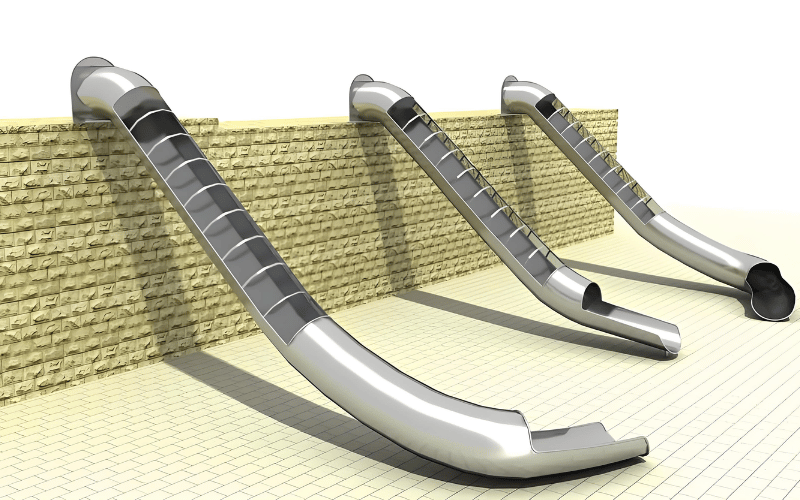Playground slides come in various materials, but stainless steel stands out for its durability and sleek design. This review focuses on comparing stainless steel slides with other common materials like plastic and fiberglass.
The goal is to provide a clear and unbiased evaluation. We’ll explore the benefits, drawbacks, and overall suitability of stainless steel slides for different play environments. Whether you’re designing a public park or upgrading a backyard playground, this guide will help you make an informed choice.
Playground slides have evolved over the years. Early designs often used wood or metal, but advancements in materials have introduced new options. Stainless steel, in particular, has gained popularity for its strength and aesthetic appeal.
By the end of this review, you’ll understand how stainless steel slides measure up against other materials and whether they’re the right fit for your needs. Let’s dive in!
Table of Contents
ToggleMaterial Durability and Longevity
When it comes to outdoor play equipment, durability isn’t just a feature—it’s a necessity. Over my decades in the industry, I’ve seen materials come and go, but stainless steel has consistently proven its worth. Let’s break down why it stands tall against the competition.
Corrosion Resistance and Weathering
Not all stainless steel is created equal. For playground slides, grades like 304 and 316 are the gold standards. Grade 304 offers excellent corrosion resistance, making it ideal for most environments. However, if your playground faces salty sea air or harsh chemicals, grade 316, with its added molybdenum, provides superior protection.
Unlike plastic, which can crack under extreme cold, or fiberglass, which may fade and weaken under UV exposure, stainless steel thrives in diverse climates. It shrugs off humidity, rain, and snow without losing its shine or structural integrity. I’ve seen slides in coastal parks and snowy mountain towns that look as good as new after years of use.
Structural Integrity and Vandalism
Stainless steel doesn’t just endure the elements—it stands up to wear and tear like a champion. Its resistance to physical damage, such as dents and scratches, far surpasses that of plastic or fiberglass. While plastic can warp under heavy use and fiberglass can chip, stainless steel maintains its form even in high-traffic playgrounds.
Vandalism is another challenge I’ve encountered in public play areas. Stainless steel’s tough surface resists graffiti and scratches better than softer materials. And when it comes to structural fatigue, stainless steel outlasts its competitors, often boasting a lifespan of 20 years or more with proper care.
Maintenance Requirements
Keeping stainless steel slides in top condition is surprisingly simple. A routine cleaning with mild soap and water removes dirt and grime. For tougher stains, a non-abrasive cleaner works wonders. Unlike plastic, which can stain permanently, or fiberglass, which may require repainting, stainless steel cleans up beautifully with minimal effort.
Minor scratches? No problem. A quick buff with a stainless steel polish can restore the surface. Over the years, I’ve advised countless clients on maintenance, and they’re always amazed at how little effort stainless steel requires.
When you factor in its low maintenance needs and long lifespan, stainless steel offers one of the lowest long-term costs of ownership. It’s an investment that pays off in durability, safety, and aesthetic appeal.
Stainless steel slides don’t just sit in a playground—they perform, endure, and shine. If you’re looking for a material that balances strength, beauty, and practicality, stainless steel is the clear winner.
| Feature | Stainless Steel | Plastic | Fiberglass |
|---|---|---|---|
| Durability | Extremely durable; resists dents, scratches, and wear over time. | It can warp or crack under heavy use or extreme temperatures. | Prone to chipping and cracking over time. |
| Weather Resistance | Excellent; resists corrosion, humidity, rain, snow, and UV exposure. | It can crack in extreme cold and fade under prolonged UV exposure. | Fades and weakens under UV exposure; less resistant to harsh weather. |
| Structural Integrity | Maintains form even in high-traffic areas; resists vandalism like graffiti. | May warp or deform under heavy use; less resistant to vandalism. | Chips and cracks more easily; moderate resistance to vandalism. |
| Maintenance | Low maintenance; easy to clean with soap and water; scratches can be buffed out. | Requires more frequent cleaning; stains can be permanent. | May require repainting and more frequent upkeep to maintain appearance. |
| Lifespan | 20+ years with proper care. | Shorter lifespan; may need replacement sooner due to wear and tear. | Moderate lifespan; may degrade faster in harsh environments. |
| Cost | Higher upfront cost but lower long-term cost due to durability and low maintenance. | Lower upfront cost but higher long-term cost due to frequent replacements. | Moderate cost; may require additional investment for maintenance. |
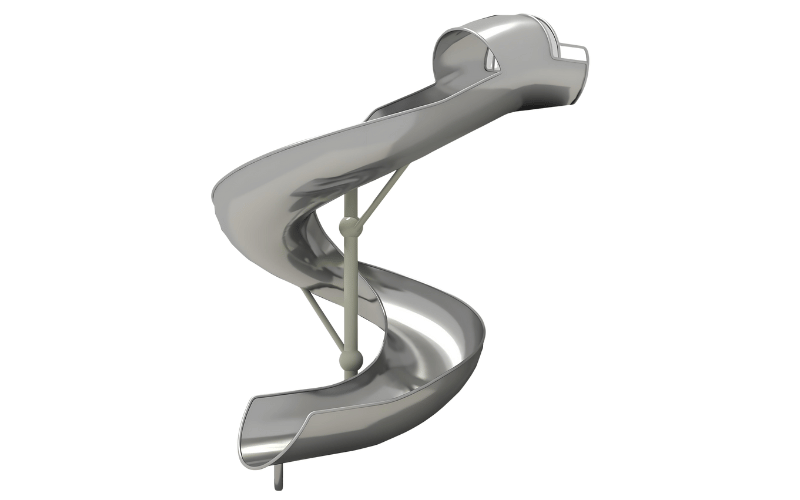
Safety and User Experience
Ensuring safety while delivering a fun and engaging experience is a balancing act in playground design. Stainless steel slides, when thoughtfully crafted, excel in providing both. Let’s explore how they address key safety concerns and enhance user enjoyment.
Heat Retention Concerns
Stainless steel is highly conductive, which means it absorbs and retains heat more readily than plastic. On sunny days, this can make the surface uncomfortably hot, especially in warmer climates. Plastic, while slower to heat up, can still reach temperatures that pose risks.
To address this, shading is essential. Overhead structures, such as canopies or pergolas, are effective in reducing direct sunlight exposure. Natural shade from trees also works well, provided the slide is positioned strategically. Additionally, some designs incorporate reflective coatings or lighter finishes to minimize heat absorption.
Testing surface temperatures is a practical step. For instance, in direct sunlight, stainless steel can exceed 120°F, while shaded slides often stay closer to 90°F. These numbers highlight the importance of planning for shade in outdoor play areas.
Friction and Speed
Stainless steel’s smooth surface creates a fast, exhilarating sliding experience. Compared to polyethylene or fiberglass, it offers lower friction, which translates to higher speeds. While this adds excitement, it’s crucial to manage speed for safety.
Design features like gentle curves or gradual slopes can help regulate descent speed. A well-designed exit zone, with a slight upward curve or extended flat section, ensures children slow down naturally before reaching the ground. This reduces the risk of abrupt stops or falls.
For younger children, textured finishes or coatings can slightly increase friction, providing a safer sliding experience without compromising the fun. These adjustments make stainless steel slides versatile for a range of age groups.
Hygiene and Cleanliness
Stainless steel’s non-porous surface is a standout feature for sanitation. Unlike plastic or fiberglass, which can trap bacteria in tiny cracks or pores, stainless steel resists microbial growth. This makes it an excellent choice for playgrounds, especially in areas with high foot traffic.
Cleaning stainless steel is straightforward. A mild soap and water solution removes dirt and grime, while a disinfectant ensures a hygienic surface. For outdoor slides, a monthly cleaning schedule is usually sufficient, though high-use areas may require more frequent attention.
The ease of maintenance and superior hygiene make stainless steel a practical choice for operators and parents alike. It not only looks polished but also provides a cleaner, safer play environment.
By addressing heat, speed, and hygiene, stainless steel slides offer a well-rounded solution for playgrounds. Thoughtful design and regular upkeep ensure they remain safe, enjoyable, and reliable for years to come.
| Feature | Stainless Steel | Plastic | Fiberglass |
|---|---|---|---|
| Heat Retention | Highly conductive; can get very hot in direct sunlight (up to 120°F). Requires shading or reflective coatings to manage heat. | Slower to heat up but can still become uncomfortably warm in direct sunlight. | Moderate heat retention; less likely to overheat compared to stainless steel. |
| Friction and Speed | Smooth surface offers lower friction, resulting in faster sliding speeds. Requires design adjustments (e.g., curves, textured finishes) for safety. | Higher friction provides slower, safer sliding speeds, especially for younger children. | Moderate friction; speed depends on surface finish and design. |
| Hygiene and Cleanliness | Non-porous surface resists bacteria and is easy to clean with soap and water. | Can trap bacteria in cracks or pores; requires more frequent cleaning. | May trap bacteria in surface imperfections; requires regular maintenance. |
| Safety Adjustments | Requires thoughtful design (e.g., shading, textured finishes, gentle slopes) to ensure safe use. | Generally safer for younger children due to slower speeds and less heat retention. | Moderate safety; requires proper design to balance speed and user experience. |
| User Experience | Provides a fast, exciting sliding experience; sleek and polished appearance enhances playground aesthetics. | Slower, more controlled sliding experience; less visually striking. | Balanced sliding experience; appearance can fade over time. |
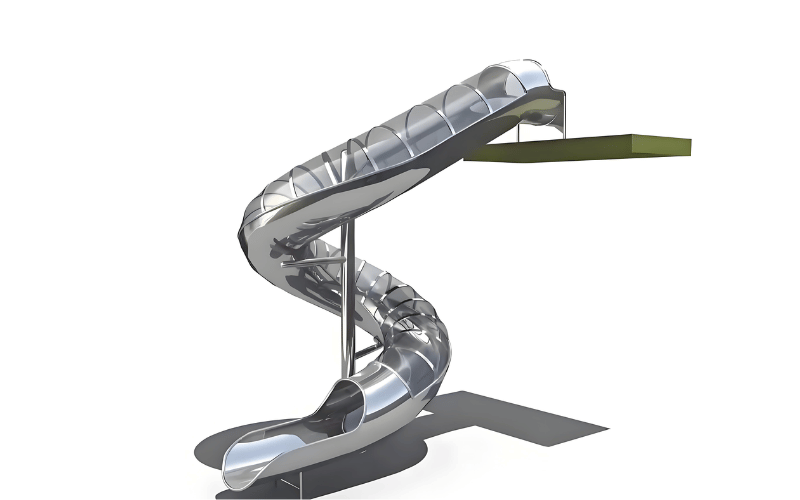
Aesthetic and Design Flexibility
Stainless steel slides don’t just perform well—they also elevate the visual appeal of any playground. Their design versatility allows them to blend seamlessly into a variety of settings while offering opportunities for creative customization.
Visual Appeal
Stainless steel brings a modern, polished look to playgrounds. Its sleek, reflective surface catches the eye and adds a sense of sophistication to the play area. Whether installed in a bustling urban park or a quiet suburban playground, stainless steel slides complement their surroundings effortlessly.
This material adapts to different architectural styles. In contemporary parks, its clean lines and metallic sheen enhance minimalist designs. In natural settings, stainless steel pairs beautifully with timber or stone, creating a harmonious blend of modernity and nature.
Reflectivity is another unique feature. Stainless steel reflects light, making the slide appear brighter and more inviting. This quality not only enhances the playground’s aesthetic but also adds a sense of openness and energy to the space.
Customization and Shapes
Stainless steel offers remarkable flexibility in design. Advanced manufacturing techniques, such as laser cutting and precision welding, allow for the creation of complex shapes. Spiral slides, wave designs, and multi-lane configurations are all achievable with stainless steel. These options provide variety and excitement for children while meeting the specific needs of the playground.
However, it’s important to note the limitations. Unlike molded plastic, which can easily form intricate, enclosed shapes, stainless steel requires more effort to achieve similar results. Fully enclosed tube slides, for example, are more challenging to produce with stainless steel. That said, open designs often work better for ventilation and visibility, making them a practical choice for many settings.
Stainless steel also integrates well with other materials. Combining it with timber frames or recycled plastic elements can create a unique, eco-friendly aesthetic. This approach not only enhances the playground’s visual appeal but also allows for creative, multi-material designs that stand out.
By balancing visual appeal with customization options, stainless steel slides offer both beauty and functionality. Thoughtful design choices can transform them into the centerpiece of any playground, ensuring they captivate children and adults alike.
| Feature | Stainless Steel | Plastic | Fiberglass |
|---|---|---|---|
| Visual Appeal | Sleek, polished, and modern; reflective surface adds brightness and sophistication. Blends well with both urban and natural settings. | Available in a wide range of colors; visually appealing for younger children but less sophisticated. | Can be painted in various colors; appearance may fade over time due to UV exposure. |
| Design Flexibility | Highly customizable with advanced techniques (e.g., laser cutting, precision welding). Ideal for spiral, wave, and multi-lane designs. | Easily molded into intricate and enclosed shapes, such as tube slides. | Moderate flexibility; can achieve unique shapes but requires more effort than plastic. |
| Material Integration | Pairs well with other materials like timber or recycled plastic for eco-friendly and unique designs. | Typically used as standalone material; less integration with other materials. | Can be combined with other materials but less common in multi-material designs. |
| Reflectivity | Reflective surface enhances brightness and creates a sense of openness. | Non-reflective; relies on color and design for visual impact. | Non-reflective; appearance depends on paint or finish quality. |
| Durability of Aesthetics | Maintains polished look over time with minimal maintenance. | Colors may fade or discolor over time, especially with prolonged UV exposure. | Paint or finish may chip or fade, requiring periodic touch-ups. |
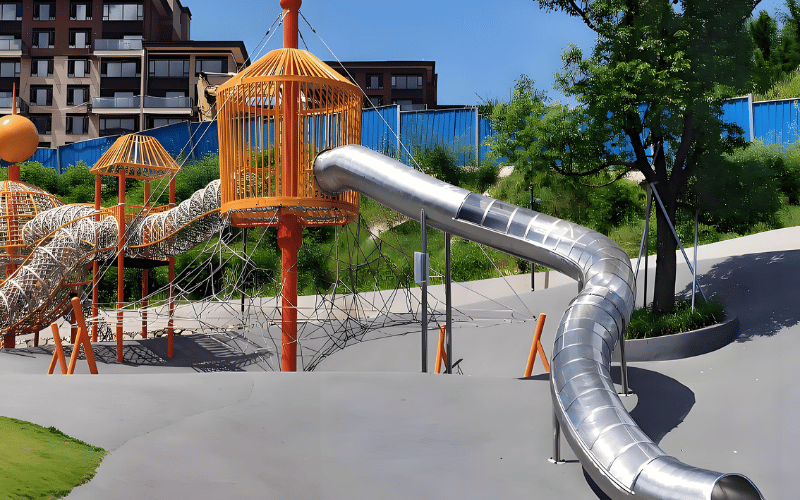
Environmental and Cost Implications
When selecting materials for playground equipment, it’s essential to consider both environmental impact and cost. Stainless steel slides strike a balance between sustainability, long-term value, and compliance with safety standards, making them a thoughtful choice for any project.
Sustainability and Recyclability
Stainless steel is one of the most sustainable materials available for playground equipment. It typically contains a high percentage of recycled content—often up to 60-70%. This means that much of the material used in a stainless steel slide has already been repurposed, reducing the demand for raw resources.
At the end of its life, stainless steel doesn’t head to a landfill. Instead, it can be fully recycled and reintroduced into the manufacturing process. This closed-loop system minimizes waste and makes stainless steel a standout choice for environmentally conscious projects.
In comparison, fiberglass and polyethylene have a more significant environmental footprint. Fiberglass is difficult to recycle due to its composite nature, and polyethylene, while recyclable, often ends up in landfills due to limited recycling infrastructure. Stainless steel’s recyclability gives it a clear edge in sustainability.
Initial Investment Cost
The upfront cost of a stainless steel slide is higher than that of plastic or fiberglass alternatives. Several factors influence this price, including the grade of stainless steel, the complexity of the design, and the manufacturing process. For example, a simple straight slide will cost less than a custom spiral design with multiple curves.
While the initial investment may seem steep, it’s important to consider the long-term value. Stainless steel’s durability and resistance to wear mean fewer repairs and replacements over time. Plastic slides, on the other hand, may crack or fade, requiring more frequent maintenance or replacement. Over a 20-year lifespan, stainless steel often proves to be the more cost-effective option.
Code Compliance and Standards
Safety is non-negotiable in playground design, and stainless steel slides must meet strict standards to ensure they are safe for children. Key standards include ASTM International guidelines and the Consumer Product Safety Commission (CPSC) regulations. These standards cover everything from slide angles and exit heights to surface finishes and temperature management.
During the design and installation process, it’s crucial to work with manufacturers and installers who understand these requirements. For example, ensuring the slide’s surface is free of sharp edges and that the exit height aligns with fall safety guidelines are essential steps. Compliance not only protects users but also reduces liability for operators.
By addressing sustainability, cost, and safety, stainless steel slides offer a well-rounded solution for playgrounds. Their environmental benefits, long-term value, and adherence to safety standards make them a smart and responsible choice.
| Feature | Stainless Steel | Plastic | Fiberglass |
|---|---|---|---|
| Sustainability | Highly sustainable; contains 60-70% recycled content and is fully recyclable at the end of its life. | Recyclable, but often ends up in landfills due to limited recycling infrastructure. | Difficult to recycle due to its composite nature, leading to higher environmental impact. |
| Recyclability | Fully recyclable in a closed-loop system, minimizing waste. | Limited recyclability; requires specialized facilities. | Not easily recyclable; often disposed of in landfills. |
| Initial Investment Cost | Higher upfront cost due to material quality and manufacturing complexity. | Lower upfront cost, making it more budget-friendly initially. | Moderate upfront cost, but varies based on design and finish. |
| Long-Term Value | Long-lasting with minimal maintenance, making it cost-effective over a 20+ year lifespan. | Shorter lifespan; frequent repairs or replacements increase long-term costs. | Moderate lifespan; may require repainting or repairs, adding to long-term costs. |
| Environmental Impact | Low impact due to recyclability and durability. | Higher impact due to shorter lifespan and disposal challenges. | Higher impact due to non-recyclable nature and potential for material waste. |
| Compliance with Standards | Meets strict safety standards (e.g., ASTM, CPSC) with proper design and installation. | Generally compliant but may require additional testing for durability and safety. | Compliant but may need extra care in design to meet safety standards. |
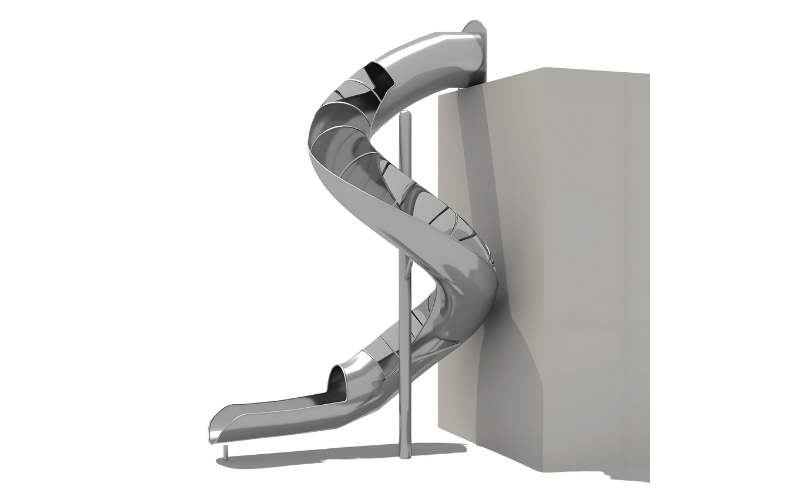
Frequently Asked Questions (FAQs)
Q: How long do stainless steel playground slides typically last?
A: Stainless steel slides can last 20 years or more with proper care. Their durability and resistance to wear make them a long-term investment for playgrounds.
Q: Do stainless steel slides get too hot to use in the summer?
A: Yes, stainless steel can get hot in direct sunlight. To prevent this, use shading like canopies or trees, or choose designs with reflective coatings to reduce heat absorption.
Q: What is the best way to clean and maintain a stainless steel playground slide?
A: Clean the slide with mild soap and water to remove dirt. For tougher stains, use a non-abrasive cleaner. Regular cleaning keeps the surface shiny and safe for use.
Q: Are stainless steel slides more expensive than plastic or fiberglass models?
A: Stainless steel slides have a higher upfront cost. However, their durability and low maintenance needs make them more cost-effective over time compared to plastic or fiberglass.
Q: Which grade of stainless steel is safest for outdoor playground use?
A: Grades 304 and 316 are the best options. Grade 304 works well in most environments, while grade 316 is ideal for areas with salty air or harsh weather conditions.
Conclusion
Advantages of Stainless Steel Slides
- Durability: Stainless steel is highly durable and resistant to wear and tear, making it a long-lasting option for playgrounds.
- Weather Resistance: It can withstand various weather conditions, including rain, snow, and UV exposure, without rusting or degrading.
- Smooth Surface: Stainless steel provides a smooth sliding surface, which can make the slide faster and more enjoyable for kids.
- Aesthetic Appeal: Stainless steel slides have a sleek, modern look that can enhance the overall appearance of a playground.
- Hygiene: The non-porous surface of stainless steel makes it easy to clean and maintain, reducing the buildup of dirt and bacteria.
- Eco-Friendly: Stainless steel is recyclable, making it a more sustainable choice compared to some plastic alternatives.
Disadvantages of Stainless Steel Slides
- Heat Retention: Stainless steel can get very hot in direct sunlight, which may make it uncomfortable or unsafe for children to use during hot weather.
- Cost: Stainless steel slides are often more expensive than plastic or other materials, which might not fit all budgets.
- Noise: Sliding on stainless steel can sometimes be noisier compared to plastic slides.
- Weight: Stainless steel is heavier than other materials, which can make installation more challenging.
When Are Stainless Steel Slides a Good Choice?
- Public Playgrounds: Their durability and weather resistance make them ideal for high-traffic areas.
- Modern Designs: If you’re going for a sleek, contemporary look, stainless steel fits the bill.
- Long-Term Investment: If you want a slide that will last for decades with minimal maintenance, stainless steel is a great option.
Tips for Using Stainless Steel Slides
- Install them in shaded areas or use covers to prevent overheating.
- Regularly inspect and clean the slide to maintain its smooth surface and safety.
- Consider pairing the slide with other materials (like plastic or wood) to balance cost and functionality.
Stainless steel playground slides offer unmatched durability, a sleek and modern aesthetic, and minimal maintenance requirements. These qualities make them a standout choice for long-term use in various play environments.
While the initial cost may be higher than plastic or fiberglass options, the long-term value justifies the investment. Proper heat management, such as adding shade or reflective coatings, ensures safe and comfortable use even in sunny climates.
For those with a focus on longevity, low maintenance, and a polished appearance, stainless steel slides are an excellent choice. Consider your budget, local climate, and expected usage to determine if this material aligns with your playground goals. When chosen thoughtfully, stainless steel slides deliver both performance and visual appeal for years to come.
In summary, stainless steel playground slides are an excellent choice for durability, aesthetics, and long-term use, but they may require some considerations for heat and cost.




